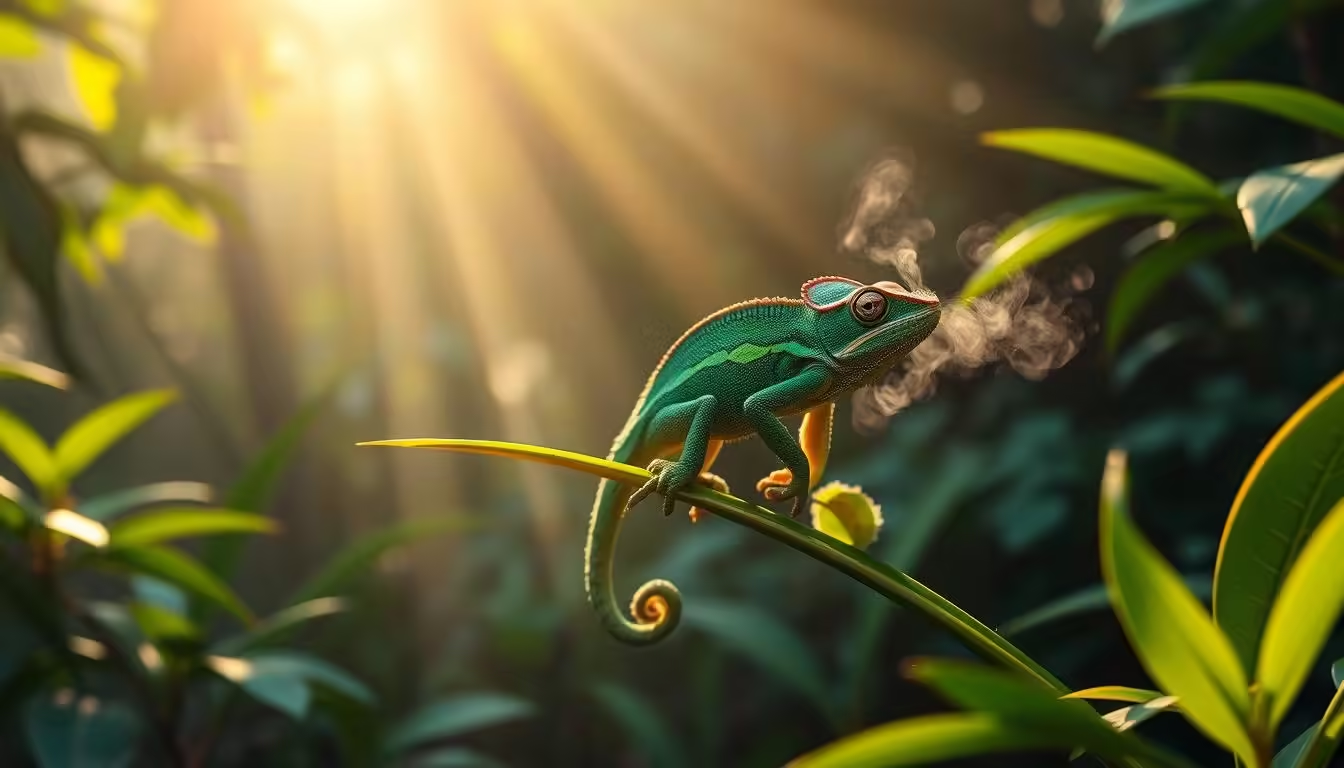A remarkable discovery was made in 2024 in the lush landscapes of Madagascar. A species of chameleon has been found to release a mist that remarkably mimics the scent of leaves. This extraordinary ability has captivated scientists and wildlife enthusiasts alike.
The chameleon’s unique trait is not just a fascinating example of mimicry in the reptile world; it also holds potential for various applications, sparking interest across different scientific disciplines.
Key Takeaways
- The chameleon’s mist mimics leaf scents, a unique trait discovered in 2024.
- This ability is a remarkable example of mimicry in the reptile world.
- The discovery has significant implications for various scientific fields.
- The chameleon’s trait is sparking interest in its potential applications.
- Scientists are studying the biochemistry behind this unique ability.
The Remarkable Discovery of Madagascar's Scent-Mimicking Chameleon
A team of researchers has stumbled upon an extraordinary adaptation in a Madagascar chameleon, revealing its ability to replicate leaf fragrances. This groundbreaking find has opened new avenues in understanding the complex survival strategies employed by this unique species.
First Observations and Scientific Documentation
The initial observations of the scent-mimicking chameleon were made during a research expedition in Madagascar’s dense forests. Scientists documented the chameleon’s behavior, noting how it released a mist that closely resembled the scent of the surrounding foliage.
The documentation process involved extensive field notes, photographs, and video recordings. Researchers also collected samples of the chameleon’s mist and the leaves it was mimicking for further biochemical analysis.
The Significance of the 2024 Discovery
The discovery of the scent-mimicking chameleon in 2024 marked a significant milestone in herpetology. It highlighted the complex adaptations that some species have evolved to survive in their environments.
This finding has implications for understanding evolutionary biology and could inspire new approaches in fields like biomimicry and conservation.
Initial Scientific Reactions to the Finding
Upon the discovery being made public, the scientific community reacted with a mix of amazement and curiosity. Experts in biochemistry and herpetology began to speculate about the mechanisms behind the chameleon’s scent mimicry.
Many scientists are now eager to study this phenomenon further, exploring its potential applications and the insights it could provide into the natural world.
Understanding Madagascar's Unique Ecosystem
Madagascar’s ecosystem is a complex web of life that has evolved in isolation for millions of years. This isolation has resulted in a biodiversity hotspot, with a plethora of flora and fauna that are found nowhere else on Earth.
The Biodiversity Hotspot of Madagascar
Madagascar is considered one of the world’s most important biodiversity hotspots. The island is home to a vast array of endemic species that have evolved independently, making it a fascinating subject for scientific study.
- High levels of endemism among flora and fauna
- Diverse ecosystems ranging from rainforests to deserts
- Unique evolutionary adaptations due to long-term isolation
Native Chameleon Species and Their Habitats
The chameleon species native to Madagascar are incredibly diverse, with over 200 species identified. These species inhabit a range of ecosystems, from the humid rainforests of the east to the dry forests of the west.
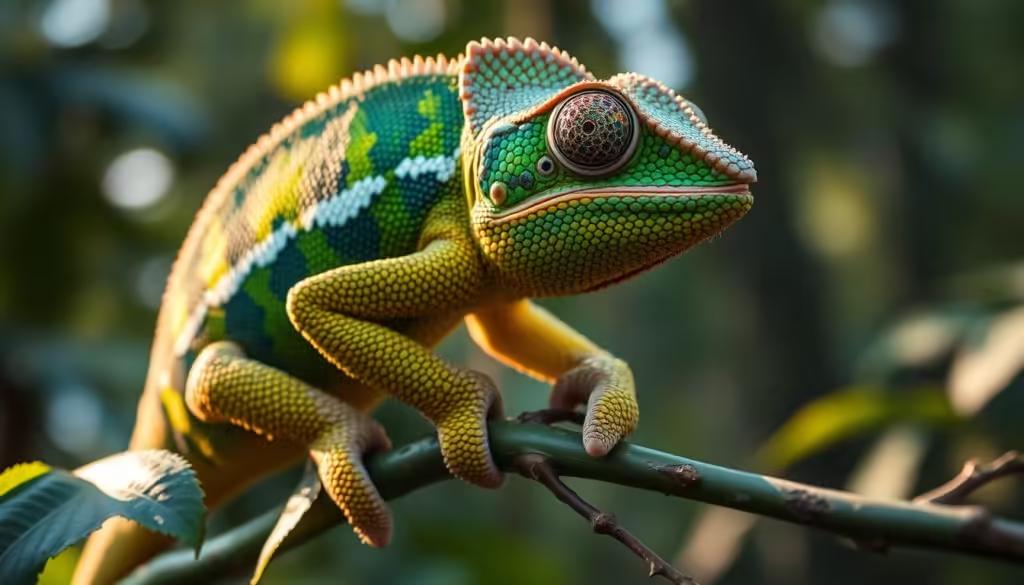
Environmental Factors Shaping Reptilian Adaptations
Several environmental factors have played a crucial role in shaping the adaptations of reptilian species in Madagascar. These include climate, habitat structure, and the presence of predators.
The unique combination of these factors has led to the development of remarkable adaptations, such as the scent-mimicking ability observed in some chameleon species.
In Madagascar, a Chameleon's Mist Mimics Leaf Scents: The Phenomenon Explained
In the lush forests of Madagascar, a unique species of chameleon has evolved an extraordinary adaptation: producing a mist that replicates the scent of leaves. This phenomenon has sparked intense scientific interest, as it represents a novel form of camouflage that goes beyond visual deception.

How the Mist is Produced by the Chameleon
The production of the mist is attributed to specialized glands located near the chameleon’s throat. These glands produce a fine spray that is released into the surrounding air, creating a mist that carries the scent of leaves.
The chameleon controls the release of this mist through a complex system involving muscular contractions and relaxations around the glandular structures. This mechanism allows the chameleon to adjust the amount of mist released according to its needs.
Chemical Composition of the Mimetic Scent
Analysis of the mist’s chemical composition reveals a complex blend of volatile organic compounds (VOCs) that closely mimic the scent of leaves. The primary components include terpenes and terpenoids, which are common in plant foliage.
| Chemical Compound | Concentration in Mist | Presence in Leaf Scent |
|---|---|---|
| Terpinolene | 25% | Yes |
| Limonene | 30% | Yes |
| Pinene | 20% | Yes |
Comparison with Actual Leaf Scents in the Habitat
Studies comparing the chemical composition of the chameleon’s mist with the scent of leaves in its habitat show a high degree of similarity. This similarity is crucial for the effectiveness of the chameleon’s camouflage, as it makes it difficult for predators to distinguish between the chameleon and its surroundings.
The ability of the chameleon to mimic leaf scents so accurately highlights the sophisticated nature of its adaptation. Further research into this phenomenon could provide insights into new forms of camouflage and deception in various fields.
The Unique Biology of the Scent-Mimicking Chameleon
The scent-mimicking chameleon, found in Madagascar, boasts a unique biology that aids its survival. This remarkable reptile has evolved several distinct features that enable it to thrive in its environment.
Physical Characteristics and Taxonomy
The scent-mimicking chameleon belongs to the family Chamaeleonidae and is classified under the genus Furcifer. It exhibits typical chameleon characteristics, such as a laterally compressed body and a prehensile tail. However, it also displays some unique physical traits, including enlarged, granular scales on its dorsal surface that may aid in mist production or retention.
| Characteristic | Description |
|---|---|
| Body Color | Variable, with shades of green and brown |
| Scale Texture | Granular on dorsal surface |
| Tail | Prehensile |
Specialized Glands for Mist Production
One of the most fascinating aspects of the scent-mimicking chameleon is its ability to produce a mist that mimics the scent of leaves. This is made possible by specialized glands located near the chameleon’s throat. These glands produce a complex mixture of chemicals that are released as a fine mist, effectively camouflaging the chameleon’s presence.
Other Adaptations Working Alongside Scent Mimicry
In addition to its scent-mimicking ability, the chameleon has developed other adaptations to ensure its survival. Its color-changing skin allows it to blend in visually with its surroundings, while its slow movements and ability to remain still for extended periods make it difficult to detect. These adaptations work in concert with the scent mimicry to provide comprehensive camouflage.
Beyond Visual Camouflage: The Evolution of Olfactory Deception
Beyond the realm of visual camouflage, certain species have evolved to deceive through scent, a phenomenon exemplified by Madagascar’s unique chameleon. This extraordinary adaptation highlights the complex interplay between predators, prey, and their environment, driving the evolution of sophisticated survival strategies.
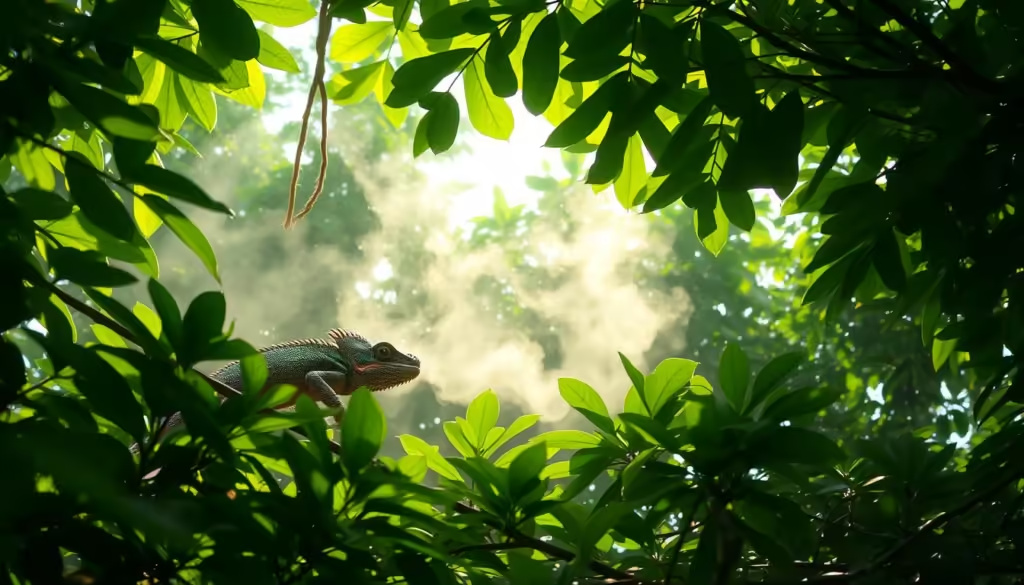
Traditional Camouflage Mechanisms in Reptiles
Reptiles have long been known for their visual camouflage abilities, blending into their surroundings to avoid detection. However, the chameleon’s ability to mimic leaf scents represents a significant advancement in camouflage techniques, leveraging the sense of smell to achieve deception.
- Visual camouflage involves changing color or texture to blend with the environment.
- Olfactory deception, on the other hand, involves mimicking scents that are either benign or indicative of a non-prey item.
The Evolutionary Advantage of Scent Mimicry
The ability to mimic leaf scents provides a significant evolutionary advantage to the chameleon, primarily by reducing its chances of being detected by predators. This adaptation allows the chameleon to remain in its habitat without being easily located, thus enhancing its survival chances.
The evolutionary advantage can be attributed to several factors, including:
- The complexity of the scent mimicry, making it hard for predators to distinguish between actual leaves and the chameleon’s mist.
- The specificity of the scent to the chameleon’s habitat, ensuring that the mimicry is effective in its native environment.
Similar Adaptations in Other Species
The phenomenon of olfactory deception is not unique to Madagascar’s chameleon. Other species have also evolved similar adaptations to deceive predators or prey. For instance, certain insects can mimic the scent of their predators to avoid being eaten, while some plants release scents that attract pollinators or repel herbivores.
Examples include:
- Insects that mimic pheromones to confuse or deter predators.
- Plants that release specific scents to attract beneficial insects or deter pests.
These adaptations underscore the diverse and creative strategies that have evolved in nature to ensure survival, highlighting the importance of olfactory deception as a survival tactic.
The Science Behind Olfactory Mimicry
Understanding the science behind olfactory mimicry requires a deep dive into the biochemical processes that enable this unique adaptation. Olfactory mimicry in Madagascar’s chameleons is a complex phenomenon that involves the production and release of scents that mimic the surrounding foliage.
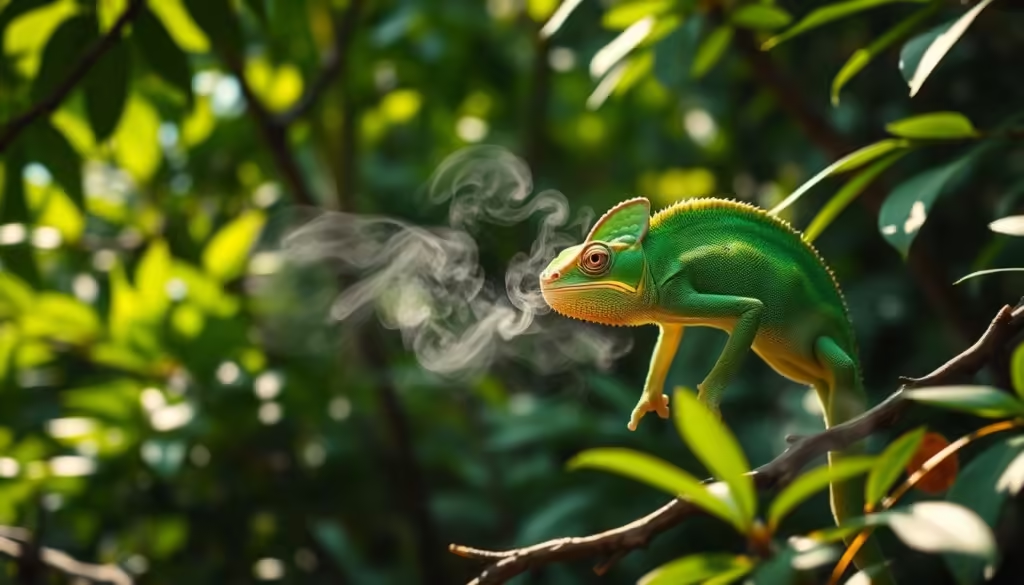
Biochemical Processes at Work
The biochemical processes underlying olfactory mimicry are intricate and highly specialized. The chameleon’s ability to produce a mist that mimics leaf scents involves a series of chemical reactions that result in the production of specific volatile organic compounds (VOCs). These VOCs are identical to those emitted by the leaves in the chameleon’s habitat, creating an olfactory disguise.
The production of these VOCs is made possible by specialized glands that are capable of synthesizing complex chemical compounds. The exact mechanisms behind this process are still under study, but it is clear that the chameleon’s olfactory mimicry is a result of a sophisticated biochemical process.
How the Chameleon Controls Scent Release
Controlling the release of the scent is crucial for the effectiveness of the olfactory mimicry. The chameleon has developed mechanisms to regulate the amount and timing of scent release, ensuring that it blends in with the environment without being overly conspicuous.
This control is likely achieved through a combination of physiological and neurological processes that allow the chameleon to adjust its scent production based on its surroundings and needs.
Seasonal and Environmental Variations in Scent Production
Scent production in the chameleon is not static; it varies with seasonal and environmental changes. As the composition of VOCs in the leaves changes with the seasons, the chameleon’s scent production adapts to match these changes, ensuring continuous camouflage.
This adaptability is a testament to the chameleon’s remarkable ability to integrate its olfactory mimicry with its environment, showcasing a highly evolved survival strategy.
Predator-Prey Dynamics: How Scent Deception Ensures Survival
The chameleons of Madagascar have developed a sophisticated survival tactic that involves mimicking the scent of leaves. This unique adaptation plays a crucial role in their predator-prey dynamics, significantly enhancing their chances of survival.
Natural Predators of Madagascar Chameleons
Madagascar’s chameleons face predation from various species, including birds of prey, snakes, and other larger reptiles. These predators rely heavily on their sense of smell to locate prey. The table below highlights some of the key predators and their characteristics.
| Predator | Characteristics |
|---|---|
| Birds of Prey | Sharp eyesight, keen sense of smell |
| Snakes | Highly developed olfactory system |
| Larger Reptiles | Strong predatory instincts, varied sensory capabilities |
How Predators Are Fooled by the Scent Disguise
The chameleon’s ability to mimic leaf scents effectively disguises their presence from predators. By releasing a mist that chemically resembles the surrounding foliage, these chameleons create a “scent camouflage” that confuses predators and makes it difficult for them to locate their prey.
“The scent mimicry exhibited by Madagascar’s chameleons is a remarkable example of evolutionary adaptation, showcasing the complex interactions between predators and prey in this unique ecosystem.”
Documented Instances of Successful Predator Evasion
Several studies have documented instances where the scent deception employed by Madagascar’s chameleons has successfully deterred predators. These instances underscore the effectiveness of this adaptation in ensuring the survival of these remarkable creatures.
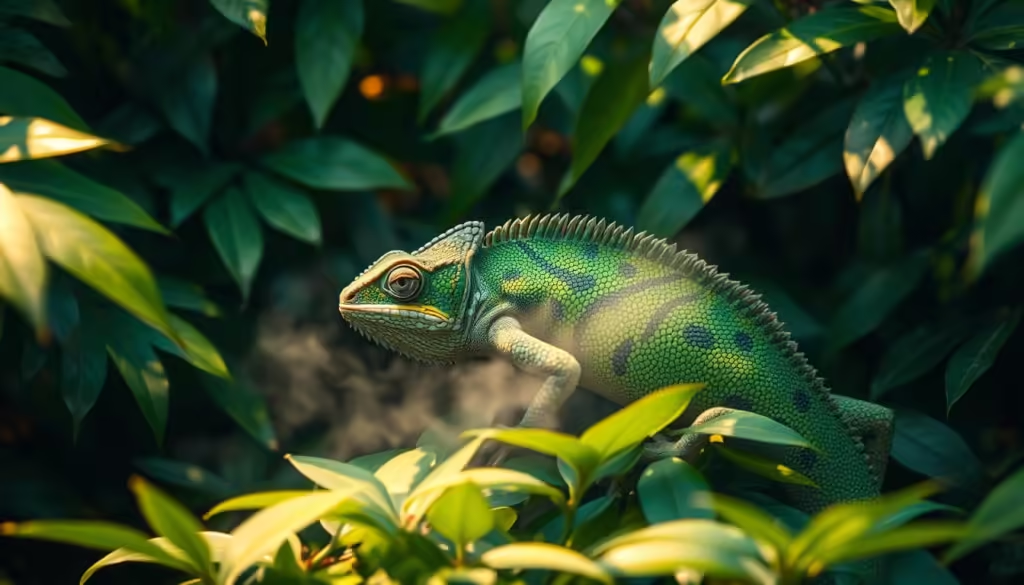
By understanding the dynamics of scent deception and its role in predator-prey interactions, researchers can gain valuable insights into the evolutionary pressures that have shaped this unique adaptation.
Research Methods and Scientific Approaches
The investigation into the scent-mimicking chameleon of Madagascar necessitates a multifaceted research approach. To comprehensively understand this unique adaptation, scientists have combined field observations with laboratory analyses.
Field Observation Techniques in Madagascar's Forests
Field observations in Madagascar’s forests are crucial for understanding the chameleon’s behavior and habitat. Researchers use techniques such as camera traps and observational studies to monitor the chameleons in their natural environment. These methods help in understanding how the chameleons produce and use the scent-mimicking mist.

Laboratory Analysis of the Mist Components
In the laboratory, scientists analyze the chemical composition of the mist produced by the chameleons. Techniques such as gas chromatography and mass spectrometry are employed to identify the specific compounds that mimic leaf scents. This analysis is critical for understanding the biochemical processes involved in scent production.
Challenges in Studying This Elusive Adaptation
Studying the scent-mimicking ability of the chameleon poses several challenges, including the difficulty of observing these animals in their dense forest habitats and the complexity of analyzing the chemical composition of the mist. Additionally, the chameleons’ ability to control scent release makes it hard to capture and analyze the mist under natural conditions.
Potential Applications Inspired by the Chameleon's Mist
The chameleon’s unique adaptation of producing a mist that mimics leaf scents has sparked interest in various potential applications. This remarkable ability has inspired scientists to explore new technologies that could revolutionize several industries.
Biomimicry in Defense Technology
The chameleon’s scent mimicry has significant implications for biomimicry in defense technology. By developing materials or systems that can mimic or counteract specific scents, military forces could gain a strategic advantage. For instance, camouflage technologies that confuse or mislead enemy sensors could be developed.
Potential Medical and Commercial Applications
Beyond defense, the chameleon’s adaptation has potential medical and commercial applications. For example, understanding how the chameleon produces its mist could lead to innovations in fragrance delivery systems or even medical diagnostic tools. The table below outlines some potential applications:
| Industry | Potential Application | Benefit |
|---|---|---|
| Defense | Advanced camouflage systems | Enhanced stealth capabilities |
| Medical | Diagnostic tools based on scent analysis | Early disease detection |
| Commercial | Fragrance delivery systems | Innovative scent marketing |
Future Research Directions and Unanswered Questions
While the potential applications are vast, there are still many unanswered questions. Future research should focus on understanding the biochemical processes behind the chameleon’s mist production and how these can be scaled or adapted for various uses. As scientists continue to study this remarkable adaptation, we can expect to see innovative solutions emerge across multiple industries.
Conclusion: Nature's Ingenious Adaptations
The discovery of Madagascar’s scent-mimicking chameleon is a testament to nature’s incredible ability to craft ingenious adaptations. This remarkable reptile has evolved a unique defense mechanism, releasing a mist that mimics the scent of its surroundings, making it nearly undetectable to predators.
The chameleon’s scent mimicry is a prime example of the complex and fascinating strategies that have evolved in the natural world. By studying such adaptations, scientists can gain a deeper understanding of the intricate relationships between species and their environments.
As we continue to explore and learn from nature’s ingenious adaptations, we may uncover new insights and inspiration for innovative solutions in various fields, from defense technology to medical applications. The chameleon’s remarkable ability to blend in through scent mimicry serves as a reminder of the awe-inspiring diversity and complexity of the natural world.
FAQ
What is the unique ability of the chameleon found in Madagascar?
The chameleon has the ability to mimic leaf scents through a mist, providing it with olfactory camouflage.
When was the discovery of the scent-mimicking chameleon made?
The discovery was made in 2024, and it has since garnered significant attention from scientists.
How does the chameleon produce the mist that mimics leaf scents?
The chameleon produces the mist through specialized glands, although the exact biochemical process is still being studied.
What are the potential applications of the chameleon's scent-mimicking ability?
Potential applications include biomimicry in defense technology, as well as potential medical and commercial uses.
How does the chameleon's scent mimicry help it evade predators?
The scent mimicry fools predators by making the chameleon blend in with its surroundings, making it harder to detect.
What are some of the challenges in studying the chameleon's scent-mimicking adaptation?
Challenges include conducting field observations in Madagascar’s forests and analyzing the mist components in a laboratory setting.
Are there other species that exhibit similar adaptations to the scent-mimicking chameleon?
While the chameleon’s adaptation is unique, other species may exhibit similar olfactory deception mechanisms, and scientists are studying these phenomena.
What is the significance of the 2024 discovery in the context of wildlife and natural camouflage?
The discovery highlights the ingenuity of natural adaptations and provides insights into the complex interactions between species and their environments.
How does the chameleon's mist compare to actual leaf scents in its habitat?
The chameleon’s mist is chemically similar to the scents of leaves in its habitat, making it an effective form of camouflage.
What are the next steps in researching the scent-mimicking chameleon?
Future research directions include further studying the biochemical processes involved, as well as exploring potential applications inspired by this unique adaptation.

